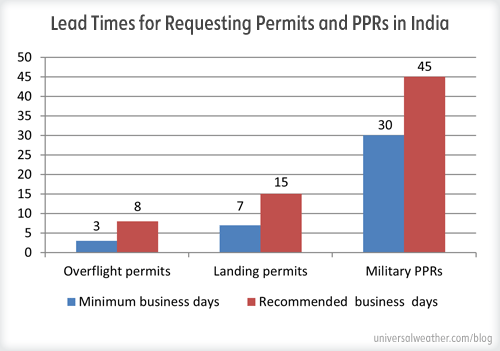10 Tips for Navigating India’s Permits, PPRs and Slots

This business aviation blog post is part of a series on operating to India and continues from our last post titled: 5 Guidelines for Flight-Planning Your Way Through India.
While the permit process for India can be lengthy and complex at times, the good news is that this region is evolving as an important, business aviation-friendly operating environment. With proper pre-trip planning, a trip to India should be a straightforward and rewarding experience for crew members.
1. Make sure your permit request is submitted with required lead time
One of the biggest challenges in India is the official requirement of time needed to acquire permits. For overflight permits, the requirement is three working days, while for landing permits, it’s seven working days. If your permit application is not complete, it will be rejected. Permits for India take a longer time to process compared to the time in many other countries, but there’s a reason for that: It generally takes the full seven days, internally, to go through all the paperwork and circulate it among the various agencies and departments.
It also needs to be mentioned that the maximum length of stay for a foreign-registered aircraft in India is 14 days. If you are planning on staying longer, you will have to depart the country with the aircraft on the 14th day. You can stop in places like Kathmandu, Nepal (VNKT); or Dhaka, Bangladesh (VGHS) and return to India the same day. Please note that additional permits will be required, so you’ll need to make advanced arrangements.
Why a lead time of 7 working days? India’s permit process explained:
Once a request comes in, it first goes to the Ministry of Civil Aviation (MOCA) asking for permission to overfly, land, park or take off. MOCA must be notified of all operator requests. After this, the request moves on to the Director General of Civil Aviation, which will grant you, based on provided documentation, a permit to fly over or into the country. Slots, schedule or overflight requests will then be cleared. The flight request is circulated internally to the Ministry of Intelligence, the Home Ministry and various offices, depending on the airports into which you’ll be flying. Based on the sensitivity of the airport or overflight area, there may be delays. Once your slots are cleared, all permit documentation is forwarded to the Bureau of Civil Aviation Security. Your handler then takes the planned schedule and applies for passes to enter the terminal and airside, as there are various levels of security to consider. Passes are generally effective for about 24 hours before arrival of the flight to 12 hours after planned arrival. Once these passes are cleared, the process moves over to handling and confirmation of all handling arrangements.
A “VT” Indian-registered aircraft arriving from an international destination will be subject to the same rules and permit requirements as a foreign-registered aircraft. However, the permit process moves faster for locally registered aircraft.
Be aware that India is particular about its airspace, airports and who flies in and out of the country. It’s the job of the Bureau of Aviation Security to control all entry and exit of international and domestic airfield movements by non-scheduled flights.
2. Take additional steps for military airfield Prior Permission Required (PPR) requests
All military airports, including the popular Agra (VIAG), require 30 days’ notice for landing and PPR clearance. However, don’t leave your permit request until 31 days before departure. We find it best that you initiate the permit process at least 45 days in advance. Additional paperwork is required for both passengers and crew, and this process can be extensive. We experience challenges at times with entry permits for military airfields, but these challenges are manageable. The best time to operate to VIAG during winter is between 0700Z and 0939Z. Any flight to a military airport delayed by more than one hour from approved timing requires further and fresh clearance. Arrival in advance of the approved time is not allowed.
Keep in mind that everything has to be concise with India permit applications, or they’ll reject your application, in which case you’ll have to reapply. Particularly when flying to military airfields, it’s important to use an experienced 3rd-party provider to set up your trip. Get all trip details to your support provider as soon as possible.
3. Understand the effect of your departure point
India has no published cabotage regulations. Passengers can be boarded at any destination port where the aircraft is cleared to operate. In India, the origin of a flight is a more important consideration for the permit process than whether you’re operating privately or as a charter. In fact, it does not make a significant difference to the permit process if you operate privately or charter. You must provide the same documentation as an Indian-registered aircraft coming in from an international destination, and your entire trip must be mapped out, with point of entry, specified domestic legs and point of exit defined very clearly. Cabotage rules in India lack clarity. India will allow charter flight activity within the country. There are generally no problems picking up Indian nationals and flying them within the country. If you abuse the permit process – for example, you operate into India empty and fly people around the country before leaving India empty – it’s possible that Indian authorities will pick up on this eventually. We’re not aware of any cabotage penalties applied to date.
4. Say goodbye to surety bonds
In the past, among the documentation requirements was a request to provide a surety bond. This document used to be required by the government authority, and it needed to be submitted along with the other documents in advance in order to obtain the landing permit. Since then, surety bond requirements for operating a foreign-registered corporate aircraft have become obsolete.
5. Know your insurance requirements
There are no special insurance requirements in place when overflying India or landing at Indian airports. The exception here is if you are conducting aerial photography. Otherwise, standard worldwide insurance with war-risk clauses and appropriate 3rd-party legal liability will suffice for operations to India.
6. Be aware of airport slots
Crews need to be diligent when flying to India during peak hours. Some airports in India have airport slot requirements, and these slots are defined in the permit process. For General Aviation (GA), there may be airport slot closures (for example, 8-10 a.m.) due to airline activity, and you may have to revise your airport slot close to day of ops. These curfews on business aircraft activity are likely to increase as airline activity continues to expand at double-digit rates. During busy periods, Air Traffic Control (ATC) can and will give you delays – often by as much as one to two hours. If the airport authorities decide to change your slot, they can do this and will coordinate revised slots with ATC. However, if you need to make a significant change to an airport slot, it may become necessary to begin the permit process again. Parking slots are typically issued two hours prior to landing. Should you decide to depart early, airport slots can be adjusted based on availability.
7. Know India’s tolerances for permit changes
If you want to make a change to flight time or routing, you’ll usually have to revise your permit and give three business days’ notice. Your ground handler may be able to use local professional relationships within India to expedite change requests, while always being compliant with applicable regulations.
Flight diversions for weather or technical reasons can be accommodated. If your aircraft is Aircraft on Ground (AOG), it may be possible to transfer your permit to another aircraft flying the same schedule. However, we had a case recently where an operator’s AOG aircraft was replaced by a different aircraft for the trip to India, and the operator was required to reapply for permits. Weather-related re-routes are considered on a case-by-case basis. But, if you just need to change a routing or destination, this may necessitate a new permit application. Last-minute changes can often be difficult. If you’re flight-planned to Delhi and want to fly to Mumbai at the last minute, this will not be approved, and you’ll need to reapply for a permit, which may result in delays.
8. Be prepared to pay cash for permits unless credit has been established in advance
Fees and landing permit costs usually depend on the Maximum Takeoff Weight (MTOW) of the aircraft. Landing permits and clearances must be settled on arrival – either by demand draft or cash. There’s no form of credit available. Even overflight permits must be settled in cash or demand draft. It’s very important to have credit established in advance by a qualified support provider.
9. Know your destination requirements
If you’re flying from a military or secondary airfield, your service provider will usually have a supervisory agent on the ground 24 hours prior to your operation. This agent will ensure that all ground handling and documentation are in place for the day of planned operation. Be aware that the military often has its own rules when it comes to its airspace. You may, for example, be able to land at a civilian airport with 1,000 feet of visibility, but a controller at a military airfield may tell you not to land if visibility is below 2,000 feet.
10. Confirm your parking in advance
Parking availability is usually good at major airports, particularly at the new Bangalore (VOBL) airport. Parking issues, and lack of longer-term parking, can occur at Mumbai (VABB). Hangar availability varies from airport to airport. We anticipate that corporate aircraft parking availability may become more restrictive in the future due to continued and dramatic increases in commercial aviation activity within India. While there are currently no noise restrictions within India, you will often run into curfews on GA movements during peak commercial airliner operating times.
Conclusion
India has different challenges and opportunities compared to other locations in Asia. As a country, India is very focused on aviation, supports GA activity and has plans to build more airports. Looking to the future, we anticipate that the number of days now officially required to arrange overflight and landing permits will reduce – just as it has in recent years in China.
Questions?
If you have any questions about this article, contact Christine Vamvakas at christinevamvakas@univ-wea.com.
Later we’ll discuss aircraft ground handling and fueling in India.
GMJG4DPJT6W3





